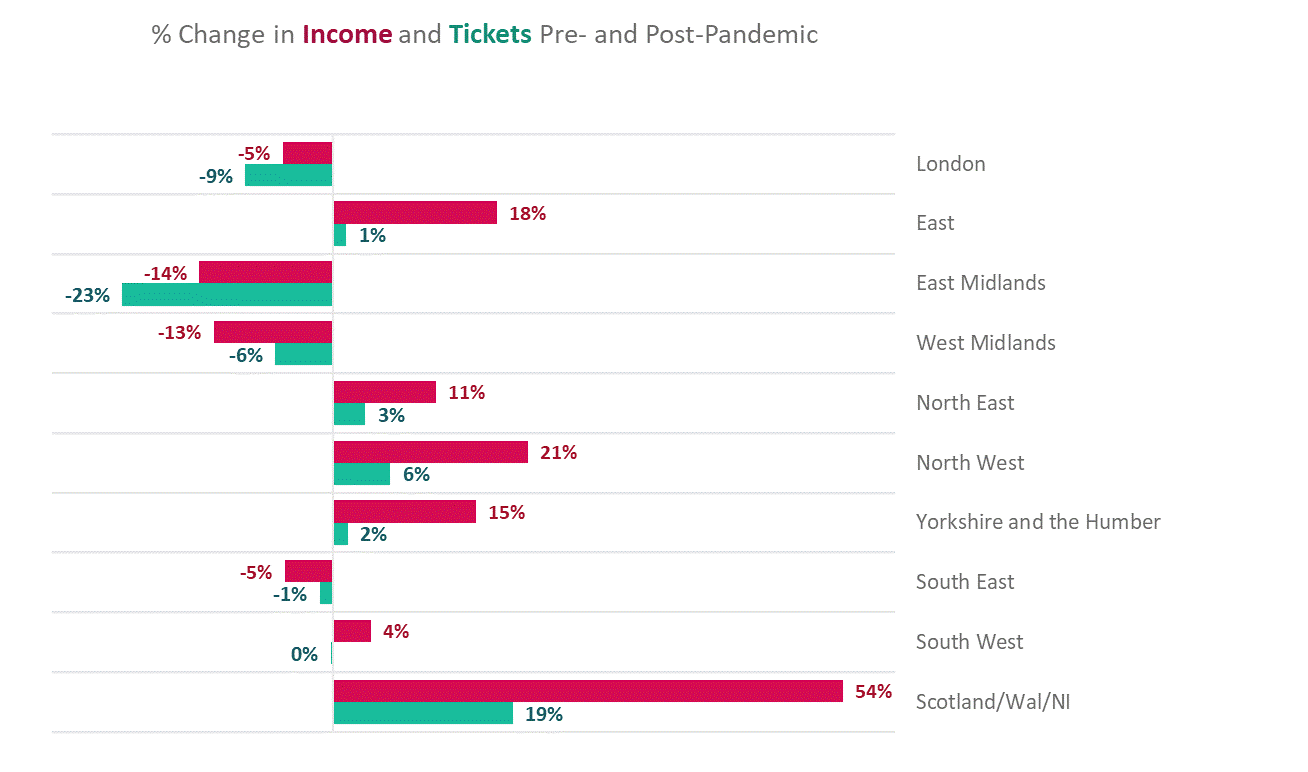How audiences' spending and attendance habits have changed
July 2022
Contents
Themes
For the first time in 2 years, arts, culture and heritage venues were able to welcome back audiences to a 'business as usual' Spring and Summer programme, so we've considered how their return has impacted sales and income, compared with pre-pandemic levels.
Key Findings
The overall picture shows that family and regional audiences are leading the return charge that has seen sales largely recover to pre-pandemic levels.
- Sales have generally recovered. Overall, income and ticket sales were more-or-less back to their pre-pandemic average, at 101% and 96% respectively, though inflation increases and vast energy cost rises mean that real term income levels are down.
- London lags slightly behind. Sales in some areas, including London, are a little slower to recover than others, perhaps in part due to the capital's greater reliance on high-spending older audiences, like M1s, who are slower to return.
- Families' eagerness offsets elders' hesitance. Proportionally, audiences with young families, such as D1s, T1s and F2s, are leading the return charge, while older audiences, like M1s, C2s and especially H1&2s remain the most reluctant, suggesting that age and life-stage are more important factors in determining returning levels than previous cultural engagement habits.
- Some artforms are faring better than others. Again, family-forward artforms like Musical Theatre and Children's Shows (which tend to attract more mid-engaged Audience Spectrum groups) have seen large increases in ticket sales, while those from Plays/Drama and Literary Events (typically the province of high-engaged segments) have dropped - partly due to programming changes.
Income and Ticket Sales
Overall, income and ticket sales were more-or-less back to their pre-pandemic average, at 101% and 96% respectively, though inflation increases mean that real term income levels are down.

- This conceals large levels of variation by individual venue (including increases for outdoor venues): 39% of venues had seen post-pandemic income changing by more than a third, with 17% decreasing, and 22% increasing.
- These income figures do not account for inflation: allowing for 14% inflation between 2018-22, 62% of venues saw a real term drop in income, and only 38% a real terms increase. This is also in the context of greatly increased energy and staffing costs.
Area and Nation
Sales in some areas, most notably London, are a little slower to recover than others, perhaps in part due to the capital's greater reliance on high-spending older audiences, like M1s, who are slower to return.

- Looking by area and nation: London1 and the Midlands are both a little down (91% and 92% of income respectively; number of tickets 95% and 96%), offset by small increases in some other areas and nations.
- Scotland, Wales and Northern Ireland, along with the North of England have seen their incomes and ticket number increase in relation to their pre-pandemic levels, however these are small increases in actual numbers, and bums on seats remain relatively low numbers compared to London and the Midlands, even if the latter are proportionally slower to bounce back.
Returning Audience Profiles
Proportionally, audiences with (especially young) families, such as D1s, T1s and F1&2s, are leading the return charge, while older audiences (across both rural retirees and older urban professionals), like M1s, C2s, S2s and especially H1&2s remain the most reluctant, suggesting that age and life-stage are more important factors in determining returning levels than previous cultural engagement habits.

- Our segmentation analysis suggests families are attending venues more than pre-pandemic, with the number of tickets for segments like Frontline Families and Trips and Treats a lot higher (up 23% and 19% respectively).
- But that older people are not coming back in the same numbers, as is reflected in significant reductions in Home and Heritage (down by 30%), as well as several other segments (e.g. Supported Communities, Metroculturals, Commuterland Culturebuffs and Up Our Street) which are also down, by between 5% and 13%.
- Given the relative proportion of each segment within previous audiences, the greatest number of additional attendances comes from Trips and Treats, followed by Dormitory Dependables and Frontline Families. The greatest reduction in attendances comes from Home and Heritage (due to the large drop in this middle-engaged group). However, the next two largest reductions are in the relatively highly engaged Commuterland Culturebuffs and Metroculturals.
Artform Variations
Family-forward artforms like Musical Theatre and Children's Shows (which tend to attract more mid-engaged Audience Spectrum groups) have seen large increases in ticket sales, while those from Plays/Drama and Literary Events (typically the province of high-engaged segments) have dropped - partly due to programming changes.

- Some art forms are faring better than others: there are large increases in the number of tickets issued to musical theatre (+43%) and children/family events (+18%), but a large drop for plays/drama (-33%) along with a range of less-programmed art forms in these venues (e.g. literature -44%, film -25%).
A note on the analysis:
We analysed results from 100 venues across Audience Finder who had data for May/June 2017, 2018, 2019 and 2022, looking at the averages of pre-pandemic years against the 2022 figure for both total income and tickets issued. For the art form analysis, we looked at April/May/June in the same years, with a sample of 66 venues with consistent amounts of art form data coding across that period.
